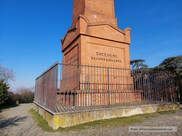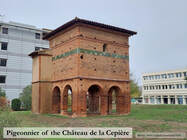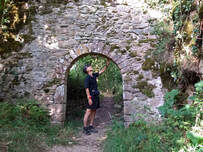|
King Wamba and the Castle of the Vultures
|

Discover a remote castle with splendid views and read the story of a rebellion against the last great king of the Visigoths. king-wamba-and-the-castle-of-the-vultures.html
|
|
Sacred, secret Pyrenees
|

I recently discovered a place which soothes the soul in these troubled times, a remote village where the church is unlocked and the bijou museum opens its doors at the touch of a button to reveal its treasures, a place with breathtaking views of Pyrenean peaks. sacred-secret-pyrenees.html
|
|
Religious pearls of the Montagne Noire
|

Discover a secret Protestant cemetery, a long-abandoned church, a bijou monastery reclaimed by the forest, and a rustic chapel which would be the perfect location for hobbits and wood elves if they were organising a wedding. religious-pearls-of-the-montagne-noire.html
|
|
Discover two English cemeteries from the Napoleonic Wars
|

Two places to the east of Toulouse are known as le cimitière des anglais, or the English cemetery. The question is, are any Englishmen buried there? This story follows on from an earlier post about the Battle of Toulouse, fought on 10 April 1814 between the armies of Wellington and Soult.when-is-an-english-cemetery-not-an-english-cemetery.html
|
|
Rarely visited due to its discreet location, this memorial celebrates a bloody battle which should never have taken place
|

The Battle of Toulouse 1814 between the armies of Wellington and Soult would never have taken place if a couple of colonels from Paris had ridden their horses a little faster. who-won-the-battle-of-toulouse-10-april-1814.html
|
|
Pigeonniers in the urban landscape of Toulouse
|

Follow this 22-kilometre circuit in Toulouse and discover eight magnificent pigeonniers built between the 17th and 19th centuries and now hidden among office blocks and housing developments. pigeonniers-in-the-urban-landscape-of-toulouse.html
|
|
A morning run through 10,000 years of history in the Montagne Noire
|

Why do I love the Lauragais and the Montagne Noire? Where else can you find a heritage trail that offers so much in such a short distance, not to mention seeing France’s most beautiful tree. Map and .gpx file included. a-morning-run-through-10000-years-of-history.html
|
|
Where three French generals rest in peace: the Protestant cemetery of Puylaurens
|

How many generals are buried in your local graveyard? I have found three in mine, all from the same family! I did not discover my three General Reys while wandering among the grandiose funerary monuments in the Catholic cemetery of Puylaurens, south-west France. Instead, I found them buried in the Protestant graveyard, hidden away on the steep northern slopes of town like a guilty family secret. where-three-french-generals-rest-in-peace.html
|
|
A rare memorial to the Wars of Religion: Soual remembers an assassination
|

This calvary in Soual may be unremarkable at first sight, but it is highly unusual. It is the only memorial I have been able to find to those who died in the Wars of Religion (if you know of any others, please let me know!). And if the mairie hadn’t recently pinned a helpful sign to the iron railings, passers-by like me would have had no clue as to its importance. a-rare-memorial-to-the-wars-of-religion.html
|
|
A lost citadel in the Montagne Noire and the origins of Revel
|

A few months ago, I took a walk in the forests of the Montagne Noire, south-west France. I waded rivers and fought dense vegetation in a bid to became one of the first people since the 12th century to visit the remains of a lost castrum – or fortified village. I say ‘lost’ because, until a year ago, it was unknown to archaeologists and historians. Although more research needs to be done, this citadel was probably called Mont-Revel, and it is mentioned in only one surviving contemporary source – an act authorising its construction signed in 1174. a-lost-citadel-in-the-montagne-noire.html
|
|
A visit to the Castrum de Roquefort – home of heretics, hideout of bandits
|

This morning I visited the historic site of Roquefort (no connection with the cheese!) while on a run in our local mountains. The earliest written reference to this fortified village dates from 1035, and for the next couple of centuries it was the home of the Roquefort family. Walking through the only gate to this well-protected community is an eerie experience. Roquefort has been abandoned and barely touched for 600 years, making it one of the least-investigated Cathar castles. a-visit-to-the-castrum-de-roquefort-home-of-heretics-hideout-of-bandits.html
|
